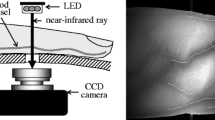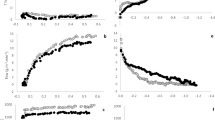Abstract
The metabolic and temperature responses of 11 male Caucasians to a 2-hr exposure to 5 ± 1°C, 70 ± 2% RH were compared with control data obtained in an ambient environment of 28 ± 1°C, 45 ± 2% RH. The heat production increased during the cold exposure attaining an approximately stable level during the final 30 min. The group variability in response to the cold was greatest during the first 30 min and declined for the remainder of the cold exposure. All skin temperatures approached a stable value during the final 30 min of cold exposure. The correlation between mean skin temperature and thigh temperature was significant (p < 0.001) and the use of thigh temperature as an approximate mean skin temperature was suggested. The calculation of tissue conductance with or without the inclusion of heat exchanges due to changes in body heat content and respiratory losses was in agreement only during the final 30 min of cold exposure, thus indicating a stage of physiological equilibrium. All measured parameters except the toe and finger temperatures approached minimum variability of response during the final 30 min of cold exposure.
Zusammenfassung
Die Reaktionen des Stoffwechsels und der Hauttemperatur von 11 männlichen Angehörigen der weissen Rasse während einer 2-stündigen Exponierung bei 5 ± 1°C, 50–70 % RF wurden mit den Kontrollwerten bei 28 ± 1°C und 45 ± 2% RF verglichen. Während der Kälteexponierung stieg die Wärmebildung an und erreichte wie die Hauttemperatur in den letzten 30 Min ein ungefähr konstantes Niveau. Die Gruppenvariabilität war in den ersten 30 Min am grössten und liess dann nach. Die Korrelation zwischen mittlerer Hauttemperatur und Oberschenkeltemperatur war hochsignifikant (p < 0,001). Es wird vorgeschlagen letztere als mittlere Hauttemperatur zu verwenden. Die Berechnung der Gewebeleitfähigkeit mit oder ohne Einbeziehung des Wärmeaustausches als Folge von Änderungen des Wärmegehaltes des Körpers und Wärmeverlustes bei der Atmung stimmte nur während der letzten 30 Min. Alle gemessenen Parameter ausser der Zehen- und Fingertemperatur näherten sich während der letzten 30 Min der Kälteexponierung einer minimalen Variabilität. Dies weist auf ein physiologisches Gleichgewicht hin.
Resume
On a comparé le métabolisme et la température cutanée de 11 personnes de la race blanche caucasienne exposées durant 2 heures à une température de 5 ± 1°C et à une humidité relative de 70 ± 2% aux mêmes valeurs obtenues par 28 ± 1°C et 45 ± 2%. La production de chaleur a augmenté durant l'exposition au froid pour atteindre un niveau relativement stable durant les 30 dernières minutes. La variabilité du groupe quant à la réaction au froid fut très importante durant les 30 premières minutes. Elle a notablement diminué le reste du temps. Toutes les températures cutanées se sont stabilisées durant les 30 dernières minutes de l'exposition au froid. La corrélation entre la température de la peau et celle de la cuisse fut hautement significative (p < 0,001) et l'on propose d'utiliser cette dernière température comme température cutanée moyenne. Le calcul de la conductibilité des tissus en y incluant ou excluant les échanges de chaleur dus aux variations thermiques du corps ou les pertes imputables à la respiration n'est exact que pour les 30 dernières minutes. Tous les paramètres mesurés, à l'exception des températures des doigts et des orteils tendent vers un minimum de variabilité durant ce même laps de temps. Ceci indique qu'un état d'équilibre physiologique est alors atteint.
Similar content being viewed by others
References
BENZINGER, T.H., PRATT, A.W. and KITZINGER, C. (1961): Thermistatic control of human metabolic heat production. Proc.nat. Acad. Sci. (Wash.), 47: 730–739.
BURTON, A.C. (1935): The average temperature of the tissue of the body. J. Nutr., 9: 261–280.
BUSKIRK, E.R., THOMPSON, R.H. and WHEDAN, G.D. (1963): Metabolic response to cold air in men and women in relation to total fat content. J.appl.Physiol., 18: 603–612.
HARDY, J.D. (1961): Physiology of temperature regulation. Physiol. Rev., 41: 521–607.
NADEL, E.R. and HORVATH, S.M. (1970): Comparison of tympanic membrane and deep body temperatures in man. Life Sci., 9: 869–875.
NELSON, N., EICHNA, L.W., HORVATH, S.M., SHELLEY, W. and HATCH, T.F. (1947): Thermal exchanges of man at high temperatures.Amer. J.Physiol., 151: 626–652.
O'HANLON, J. F., Jr. and HORVATH, S.M. (1970): Changing physiological relationships in man under acute cold stress. Canad. J. Physiol. Pharm., 48: 1–10.
RAVEN, P. B., NIKI, I., DAHMS, T.E. and HORVATH, S.M. (1970): Compensatory cardiovascular responses during an environmental cold stress, 5°C. J. appl. Physiol. (in press).
WINER, B.J. (1962): Statistical Principles in Experimental Design. McGraw-Hill Book Co., Inc., New York, p. 672.
WYNDHAM, C.H., PLOTKIN, R., and MUNRO, A. (1964): Physiological reactions to cold of men in the Antarctic. J.appl.Physiol., 19: 593–597.
WYNDHAM, C.H., MORRISON, J.F., WILLIAMS, C.G., BREDELL, G.A.G., VAN RAHDEN, P.J., HOLDSWORTH, J.E., VAN GRAAN, L.D., VAN RENSBURGH, A.J. and MUNRO, A. (1964): Physiological reactions to cold of Caucasian females. J.appl.Physiol., 19: 877–880.
WYNDHAM, C.H., WILLIAMS, C.G. and LOOTS, H. (1968): Reactions to cold. J.appl.Physiol., 24 (3): 282–287.
YOSHIMURA, H. (1960): Acclimatization to heat and cold. In: Essential Problems in Climatic Physiology. H. Yoshimura (ed.). Nankodo Ltd. Co., Japan, 61–106.
Author information
Authors and Affiliations
Additional information
Supported in part by United States Public Health Service Grant No. HD-00235; and the Air Force Office of Scientific Research, Office of Aerospace Research, United States Air Force, under AFOSR Grant No. 69-1653. Data analysis (on IBM System 360 Model 75 computer) was made possible by funds from the Special Research Resources Branch, Division of Research Facilities and Resources, National Institutes of Health.
Rights and permissions
About this article
Cite this article
Raven, P.R., Horvath, S.M. Variability of physiological parameters of unacclimatized males during a two—hour cold stress of 5°C. Int J Biometeorol 14, 309–320 (1970). https://doi.org/10.1007/BF01742075
Received:
Issue Date:
DOI: https://doi.org/10.1007/BF01742075




